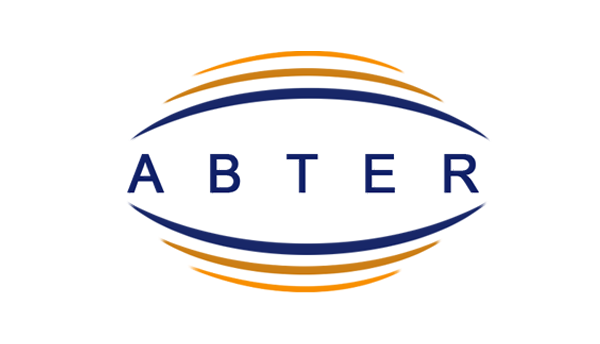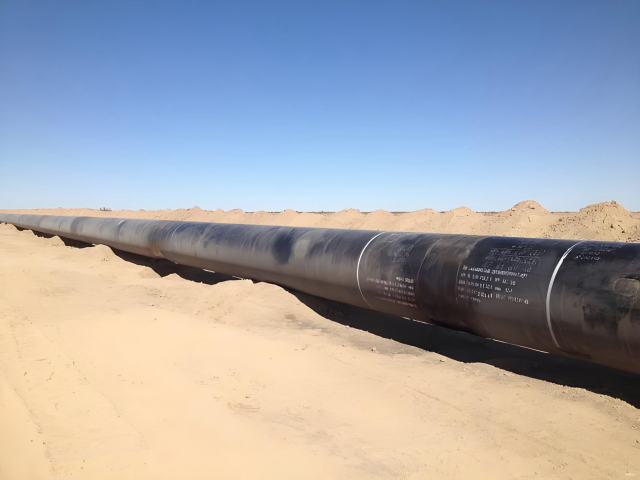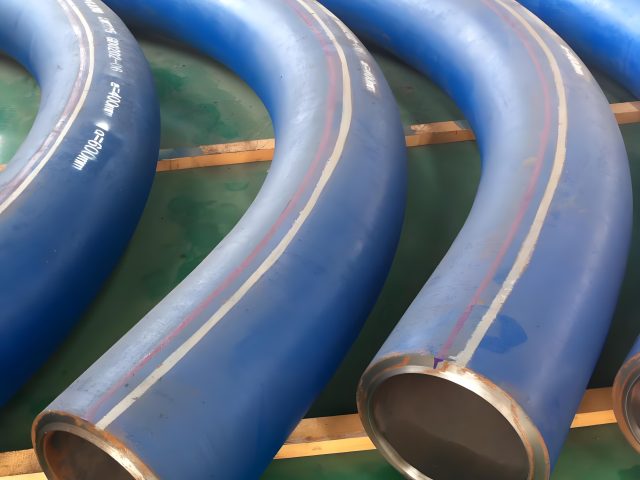3LPE Anti-Corrosion Pipes for API 5L Transmission Systems
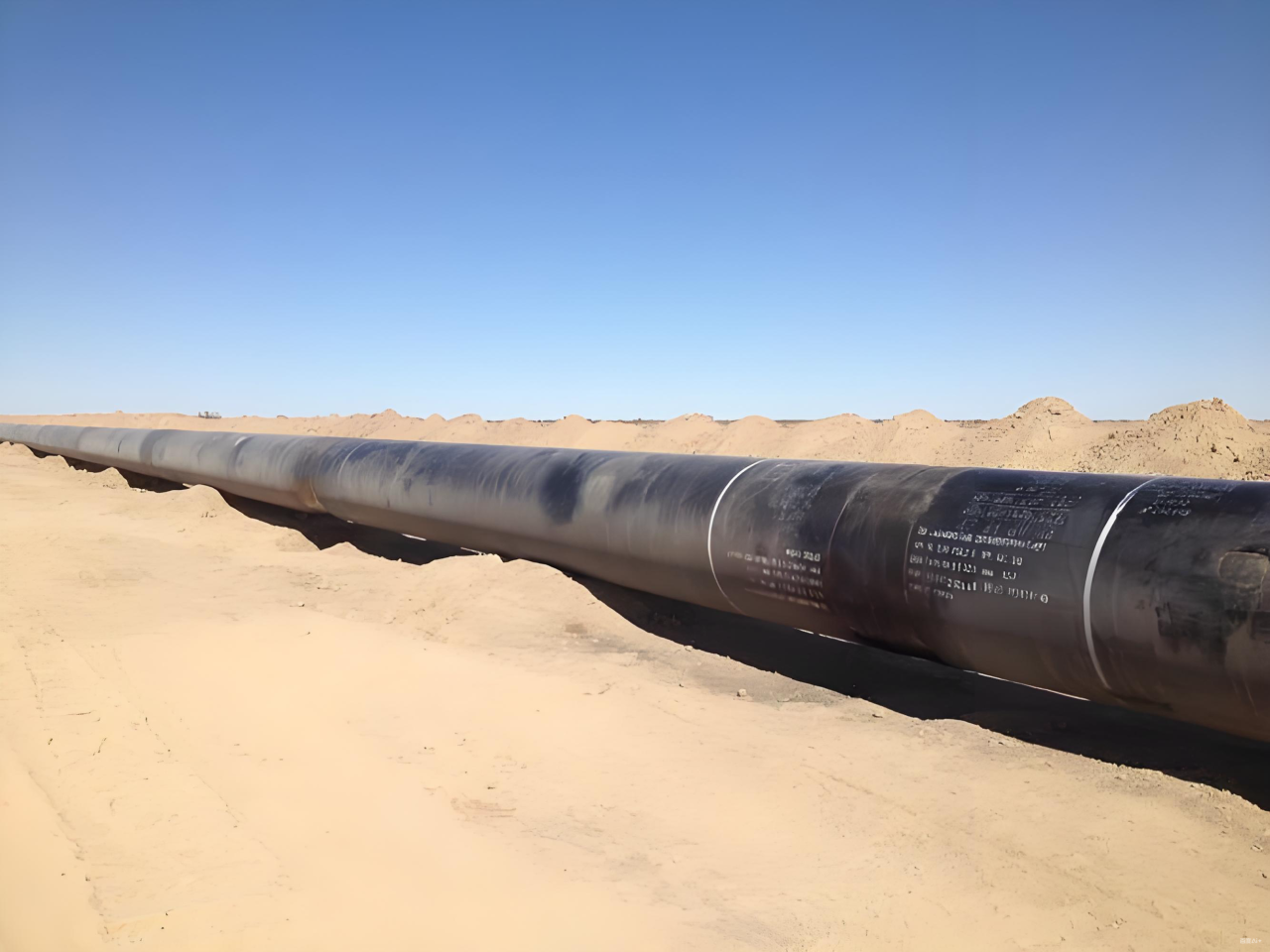
The Dual Defense: Engineering the Resilience of 3LPE Anti-Corrosion Pipes for API 5L Transmission Systems
Modern energy infrastructure, reliant upon vast networks of pipelines to convey high-pressure hydrocarbons across diverse and often hostile terrains, demands an uncompromising fusion of mechanical strength and environmental resilience. The bare steel pipe, however strong its metallurgy, is instantly vulnerable to the complex electrochemical and physical degradation inherent in soil environments. This necessity for protection gives rise to one of the most critical products in the transmission sector: the 3LPE Anti-Corrosion Pipe, founded on the robust structural integrity of API 5L Line Pipe, typically specified to the exacting standards of PSL2 (Product Specification Level 2) and manufactured in highly efficient DRL (Double Random Length) sections. This component is a system, where the high-strength steel core is meticulously armored by a three-layer polymer shell designed for decades of unwavering subterranean service.
The design of the 3LPE API 5L pipe is a testament to calculated engineering—it is a structure designed to contain high internal pressure while simultaneously managing the complex external threats of electrochemical corrosion, bacterial attack, moisture ingress, and the acute mechanical stresses induced by handling, transportation, and trench backfilling. The selection of PSL2 over PSL1 material is a conscious risk-mitigation strategy, ensuring enhanced toughness and predictable weldability essential for large-diameter, high-consequence pipelines. To understand this product is to simultaneously dissect the metallurgy of high-strength, low-alloy (HSLA) steel and the polymer science of the multi-layered coating, recognizing that the long-term reliability of the pipeline is contingent upon the perfect synergy between these two distinct but inseparable materials.
1. The Core Imperative: Defending the Structural Heart of the Pipeline
The strategic selection of API 5L line pipe as the substrate for 3LPE coating is dictated by the extreme service environment of modern pipelines. Pipelines operate under high internal pressure (often exceeding $10 \text{ MPa}$) and are subject to external static loads (soil stress) and dynamic loads (thermal expansion and contraction). Failure under these conditions is catastrophic, leading to immense economic loss and environmental disaster.
API 5L: The Standard of Line Pipe Excellence
The API 5L specification is the global benchmark for steel pipe used in the conveyance of fluids and gas. It defines a spectrum of grades, from Grade B up through the X-series (X42, X52, X65, X70, etc.), where the numerical suffix indicates the minimum guaranteed Specified Minimum Yield Strength (SMYS) in kilopounds per square inch (ksi). For instance, an API 5L Grade X65 pipe guarantees a minimum yield strength of $65 \text{ ksi}$ ($450 \text{ MPa}$). This high strength is essential for minimizing wall thickness, thus reducing the total weight and cost of the pipe required to contain the high operating pressure.
PSL1 vs. PSL2: The Strategic Choice for Critical Service
The choice between PSL1 and PSL2 is a critical engineering decision that dictates the metallurgical integrity and quality assurance level of the steel substrate:
-
PSL1 (Product Specification Level 1): Represents standard quality line pipe. It has less stringent chemical composition limits, no mandatory toughness testing (Charpy V-Notch), and fewer non-destructive testing (NDT) requirements. It is suitable for non-critical, lower-pressure service.
-
PSL2 (Product Specification Level 2): Represents high-quality line pipe designed for critical service. The PSL2 mandate imposes:
-
Tighter Chemical Limits: Significantly lower maximum limits for Carbon, Phosphorus (P), and Sulfur (S), leading to lower Carbon Equivalent (CE) for guaranteed field weldability.
-
Mandatory Toughness: CVN impact testing is required at specified temperatures (often $0^{\circ}\text{C}$ or $-20^{\circ}\text{C}$) to guarantee resistance to brittle fracture, a vital requirement in cold climates or for high-pressure gas service where rapid decompression could trigger brittle crack propagation.
-
Comprehensive NDT: More thorough inspection and testing of the pipe body and weld seam.
-
For high-consequence, high-pressure transmission pipelines, the choice is overwhelmingly PSL2, as the marginal increase in material cost is easily justified by the massive reduction in operational risk associated with superior fracture toughness and predictable weld integrity.
DRL: Optimizing Construction Logistics
The term DRL (Double Random Length) signifies the ideal operational length for pipe sections, typically ranging from $10.7 \text{ meters}$ to $12.5 \text{ meters}$. Utilizing DRL pipes is a direct cost-saving measure in pipeline construction logistics: longer pipe sections mean fewer field welds are required per kilometer of pipeline laid. Fewer welds equate to lower labor costs, reduced inspection time, and a proportional reduction in the number of potential failure points, streamlining the construction timeline and enhancing the final integrity of the pipeline.
2. The Metallurgical Foundation: API 5L Line Pipe Composition and Performance
The structural performance of the 3LPE pipe begins with the precise metallurgy of the API 5L steel. Modern high-strength grades (X60, X70, and above) fall into the category of HSLA (High-Strength, Low-Alloy) Steels, whose strength is not derived from high Carbon content (which would compromise weldability) but from advanced thermo-mechanical processing and micro-alloying techniques.
Chemical Composition: The Low CE Strategy

The chemical composition is meticulously controlled to ensure both strength and field weldability. The PSL2 requirements are particularly strict on elements that affect the heat-affected zone (HAZ) during welding:
-
Low Carbon and Manganese: Kept within strict limits to manage the Carbon Equivalent (CE) below critical thresholds (often $CE \leq 0.43$) to prevent the formation of hard, brittle martensite in the HAZ, thereby avoiding cold cracking.
-
Micro-Alloying (Vanadium, Niobium, Titanium): Minute additions of these elements are the true source of high yield strength. They form extremely fine carbide and nitride precipitates, effectively pinning the steel’s grain boundaries. This grain refinement and precipitation hardening significantly increases the SMYS while maintaining a fine-grained, tough microstructure.
-
Low Sulfur and Phosphorus: Kept extremely low (e.g., $P \leq 0.020\%$, $S \leq 0.010\%$ for PSL2) to minimize the presence of non-metallic inclusions. High sulfur creates manganese sulfide inclusions, which promote lamellar tearing and reduce fracture toughness and resistance to Sulfide Stress Corrosion Cracking (SSCC) in sour service.
Mechanical Requirements and Fracture Toughness
The tensile requirements are straightforward: the material must meet or exceed the SMYS and the specified Minimum Tensile Strength ($R_m$). For an API 5L X65 PSL2 pipe:
-
SMYS: $450 \text{ MPa}$ ($65 \text{ ksi}$) minimum.
-
$R_m$: $535 \text{ MPa}$ ($77 \text{ ksi}$) minimum.
-
Yield-to-Tensile Ratio: Strictly limited to a maximum (often $0.93$) to ensure the pipe has a sufficient margin of plastic deformation capacity (toughness) before ultimate failure.
The mandatory Charpy V-Notch (CVN) impact testing for PSL2 is the crucial guarantee of the pipe’s toughness. The test, conducted at low temperatures, ensures the pipe will absorb a specified amount of energy (e.g., $40 \text{ Joules}$ for the body, $27 \text{ Joules}$ for the weld HAZ) without propagating a brittle fracture, essential for pipeline safety in high-pressure gas service where fast fracture propagation is a major risk.
| Parameter | API 5L X65 PSL2 Specification | Standard (API 5L) | Heat Treatment / Processing |
| Minimum Yield Strength | $450 \text{ MPa}$ ($65 \text{ ksi}$) | API 5L PSL2 | Thermo-Mechanical Controlled Process (TMCP) or Normalizing / Quenching & Tempering (Q&T). |
| Maximum Carbon Equivalent | $\leq 0.43$ (Typically lower in practice) | API 5L Annex F (Weldability) | Designed via micro-alloying (V, Nb, Ti) to ensure low $\text{CE}$ after processing. |
| Minimum CVN Toughness | $\geq 40 \text{ Joules}$ (Body) at specific minimum temperature | API 5L Annex J/Annex K | Mandatory for PSL2 to guarantee fracture arrest capability. |
| Wall Thickness Schedule | Based on ASME B36.10M schedules and design pressure | API 5L & ASME B31 Codes | Tolerances on OD and WT are tightly controlled (see combined table). |
3. The Defensive Armor: The 3LPE Anti-Corrosion System
The second, equally vital, half of the product is the Three-Layer Polyethylene (3LPE) coating, which acts as a robust, long-lasting barrier against the corrosive forces of the subterranean environment. The 3LPE system is an international standard, defined primarily by ISO 21809-1 (Petroleum and natural gas industries—External coatings for pipelines) or the historical DIN 30670.
The Tri-Layered Structure and Functional Synergy
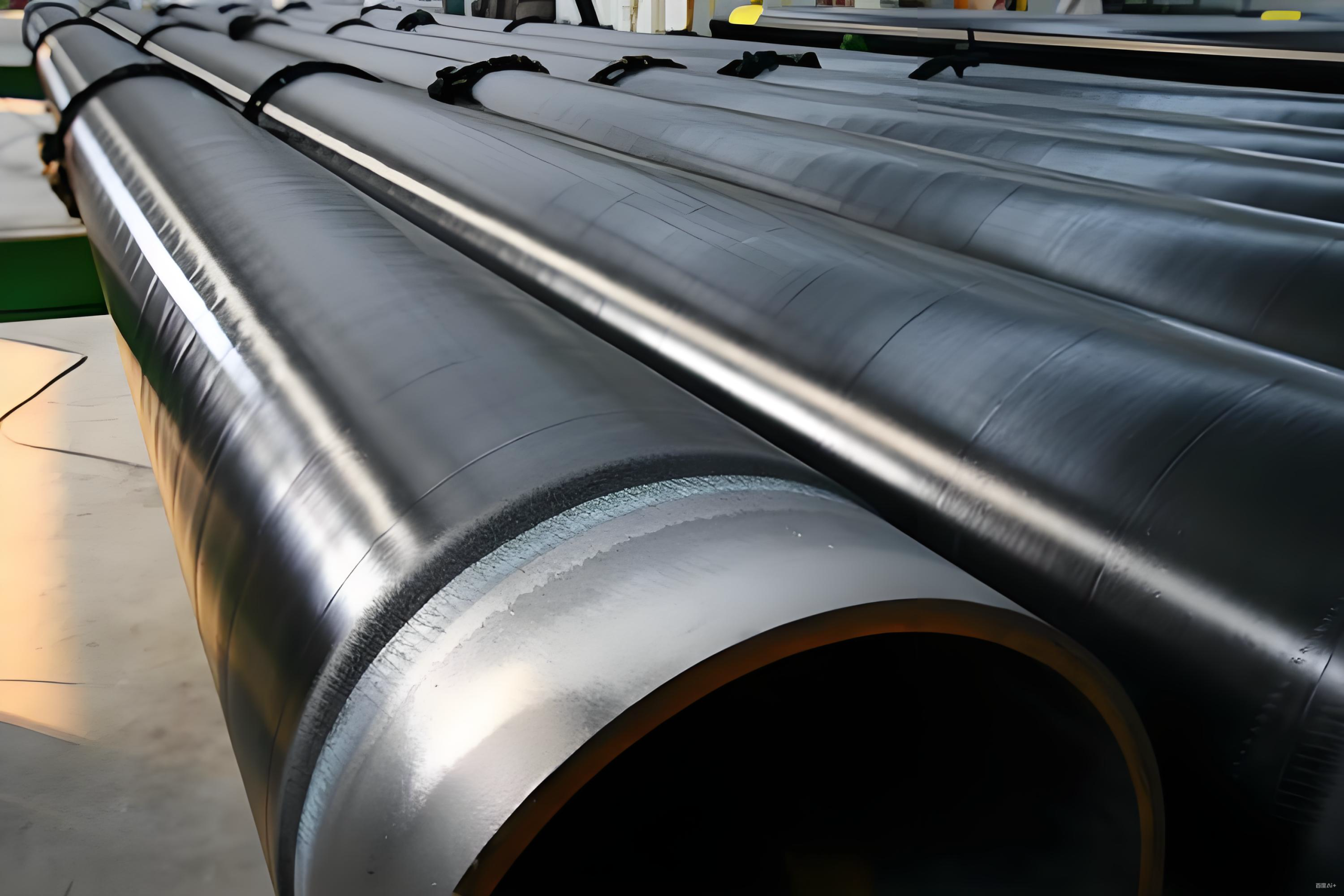
The strength of the 3LPE system lies in its functional synergy, achieved through three distinct, laminated layers, each serving a critical purpose:
-
Layer 1: Fusion Bond Epoxy (FBE): This is the primary corrosion defense layer and the foundation of adhesion. FBE is an extremely chemically resistant thermoset polymer applied electrostatically as a dry powder onto the heated steel surface. Its primary function is to provide the required electrochemical barrier and a strong chemical bond with the steel. FBE exhibits excellent Cathodic Disbondment (CD) resistance, which is the ability to resist the spreading of corrosion beneath the coating at holiday (pinhole) sites under the influence of the cathodic protection system.
-
Layer 2: Copolymer Adhesive (Co-Polymer): This is the tie-layer that chemically bonds the FBE (Layer 1) to the Polyethylene (Layer 3). It is a modified polyolefin with functional groups that react chemically with the epoxy layer while simultaneously melting and fusing with the extruded polyethylene layer. This layer ensures the integrity of the three-layer composite structure.
-
Layer 3: Extruded Polyethylene (PE): This is the mechanical and moisture barrier layer. Applied as molten plastic extruded onto the pipe, this layer provides superb resistance to soil stress, abrasion, impact damage during handling, and moisture penetration. This high-density or medium-density polyethylene (HDPE/MDPE) is UV-stabilized and extremely durable, ensuring the FBE layer remains physically protected throughout the pipe’s service life, which can span 50 to 100 years.
The Application Process and Quality Control
Achieving a high-quality 3LPE coating is an elaborate, multi-stage process where perfect surface preparation is paramount:
-
Surface Preparation (Blast Cleaning): The pipe surface is meticulously cleaned using steel grit or shot blasting to achieve a cleanliness level of SA 2.5 (Near White Metal) or SA 3 (White Metal) and a defined surface profile (roughness, typically $R_z \geq 50 \mu\text{m}$). This profile is essential for the mechanical and chemical interlocking of the FBE layer.
-
Heating and Pre-treatment: The pipe is heated to the optimal application temperature (e.g., $200^{\circ}\text{C}$ to $230^{\circ}\text{C}$) to facilitate the fusion of the FBE powder.
-
FBE Application: FBE powder is applied via electrostatic spray guns. The heat causes the powder to melt and chemically cure (cross-link) into a hard, continuous film, forming the primary bond with the steel.
-
Adhesive and PE Application: While the FBE is still hot, the Copolymer Adhesive and then the Polyethylene (PE) are applied via extrusion. The layers fuse together, forming a continuous, laminated sheath.
-
Inspection and Testing: The finished coating is subjected to non-destructive testing, primarily using a Holiday Detector (high voltage spark testing) to locate and mark any pinholes or discontinuities. The coating thickness is also verified (typically $2.5 \text{ mm}$ to $3.5 \text{ mm}$ for $3\text{LPE}$). Destructive testing (peel adhesion and cathodic disbondment) is performed on test rings or coupons to verify the system’s long-term performance guarantees.
4. Specification, Features, and Applications: The Integrated Product
The final 3LPE API 5L PSL2 DRL pipe is an integrated system designed for maximum longevity and minimum lifecycle cost. The combined features provide a component that is structurally safe and environmentally durable.
Critical Performance Metrics of 3LPE Coating
The primary measure of 3LPE quality goes beyond simple thickness:
-
Cathodic Disbondment (CD) Resistance: This is the most crucial test. It measures the diameter of the area where the coating loses adhesion around an intentional holiday (pinhole) after being immersed in electrolyte and subjected to a negative voltage (simulating cathodic protection) for a prolonged period (e.g., 28 days or 90 days) at an elevated temperature (e.g., $60^{\circ}\text{C}$). A small disbondment radius is the ultimate proof of long-term electrochemical protection.
-
Adhesion Strength (Peel Test): Measures the force required to peel the coating from the pipe surface, ensuring the fusion bond between the steel and the FBE is robust enough to withstand soil shear stress.
-
Impact and Indentation Resistance: Measures the coating’s ability to resist damage from sharp rocks or backfilling operations, ensuring the polyethylene layer maintains its mechanical barrier function.
Combined Features of the Final Product
| Feature Category | Description | Benefit to Pipeline Integrity |
| Structural | API 5L PSL2 High-Yield Steel (X42 to X70) | Contains high internal pressure with minimum wall thickness; reduced material cost. |
| Weld Integrity | Low Carbon Equivalent (CE) and Low P/S (PSL2) | Guarantees predictable field weldability and minimizes crack susceptibility in the HAZ. |
| Durability | 3LPE Layer 3 (Polyethylene) | Excellent resistance to abrasion, handling damage, and soil stress over decades. |
| Corrosion Protection | 3LPE Layer 1 (FBE) & Low CD Rate | Provides a robust electrochemical barrier; long-term protection under cathodic protection. |
| Logistics | DRL (Double Random Length) | Minimizes the number of field welds, reducing construction time, labor costs, and field risk. |
| Safety | Mandatory CVN Toughness (PSL2) | Guarantees resistance to brittle fracture and crack propagation in cold or high-stress service. |
Applications
The 3LPE API 5L PSL2 DRL pipe is the default choice for major energy transmission projects globally:
-
Onshore Oil and Gas Transmission Pipelines: Mainline pipe, especially in large diameters ($>\text{NPS } 20$), crossing varied terrains.
-
Water and Slurry Pipelines: Used in mining and municipal projects where high strength is required and external corrosion protection is necessary.
-
Distribution Networks: For large trunk lines that form the backbone of gas distribution systems, requiring long service life and high safety factors.
The tables below provide a final synthesis of the key specifications, integrating the pipe material and the coating system into a singular product definition.
Comprehensive Technical Data Tables
| Parameter | Material/Coating Standard & Specification | Steel Substrate (API 5L PSL2) | Coating System (3LPE) |
| Primary Standard | API 5L PSL2 & ISO 21809-1 (or DIN 30670) | High-Strength Low-Alloy (HSLA) Steel | Fusion Bond Epoxy (FBE), Copolymer Adhesive, Polyethylene (PE) |
| Chemical Requirement | Low CE, P $\leq 0.020\%$, S $\leq 0.010\%$ (Mandatory PSL2) | Strict limits on V, Nb, Ti content | N/A (Polymer Chemistry) |
| Heat Treatment | TMCP or Q&T (for X65 and above) | Required to achieve fine grain structure and high yield strength | Curing (Cross-linking) of the FBE layer |
| Dimension Type | DRL (Double Random Length: $10.7 \text{ m}$ to $12.5 \text{ m}$) | OD: $\pm 0.5\%$, WT: $\pm 10\%$ of nominal | Coating Thickness: Typically $2.5 \text{ mm}$ to $3.5 \text{ mm}$ |
| Tensile Requirement | Guaranteed SMYS, $\text{YS}/\text{TS}$ ratio limited ($\leq 0.93$) | N/A (Mechanical strength provided by steel) | N/A |
| Key Performance Test | CVN Impact Test (Fracture Toughness) | Cathodic Disbondment (CD), Peel Adhesion, Holiday Detection | |
| Application Focus | High-pressure, critical service, onshore transmission | Long-term corrosion protection in soil/water environments |
| API 5L Grade (PSL2 Example) | Min Yield Strength (MPa/ksi) | Min CVN Energy (Joules) | Wall Thickness Tolerances (%) |
| X42 | $290 \text{ MPa} / 42 \text{ ksi}$ | $27 \text{ J}$ | $\pm 10\%$ of nominal WT |
| X52 | $360 \text{ MPa} / 52 \text{ ksi}$ | $34 \text{ J}$ | $\pm 10\%$ of nominal WT |
| X65 | $450 \text{ MPa} / 65 \text{ ksi}$ | $40 \text{ J}$ | $\pm 10\%$ of nominal WT |
| X70 | $485 \text{ MPa} / 70 \text{ ksi}$ | $40 \text{ J}$ | $\pm 10\%$ of nominal WT |
The 3LPE Anti-Corrosion Pipe, constructed upon the structural foundation of API 5L PSL2 DRL steel, is the epitome of engineered reliability. It represents the industry’s most comprehensive answer to the dual threat of structural failure and environmental degradation. The pipe’s strength, guaranteed by the rigorous PSL2 metallurgical and mechanical specifications (especially the mandatory fracture toughness of the CVN test), ensures pressure containment.
